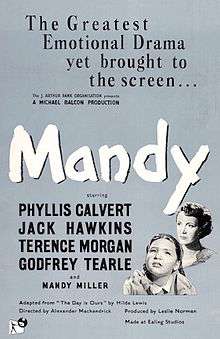Mandy (film)
| Mandy | |
|---|---|
 Original UK cinema poster | |
| Directed by | Alexander Mackendrick |
| Produced by |
Michael Balcon Leslie Norman |
| Screenplay by |
Nigel Balchin Jack Whittingham |
| Based on |
The Day Is Ours by Hilda Lewis |
| Starring |
Phyllis Calvert Jack Hawkins Mandy Miller |
| Music by | William Alwyn |
| Cinematography | Douglas Slocombe |
| Edited by | Seth Holt |
Production company | |
| Distributed by | General Film Distributors |
Release dates |
|
Running time | 93 min. |
| Country | United Kingdom |
| Language | English |
Mandy is a 1952 British film about a family's struggle to give their deaf daughter a better life. It was directed by Alexander Mackendrick and is based on the novel The Day Is Ours by Hilda Lewis. It stars Phyllis Calvert, Jack Hawkins and Terence Morgan, and features the first film appearance by Jane Asher. In the US the film was released as The Story of Mandy,[1] later also distributed as Crash of Silence.[2]
Plot
Harry and Christine Garland have a deaf daughter, Mandy. As they realise their daughter's situation, the parents enroll Mandy in special education classes to try to get her to speak. They quarrel in the process and their marriage comes under strain. There are also hints of a possible affair between Christine and Dick Searle, the headmaster of the school for the deaf where Mandy is enrolled. Eventually, the training succeeds to the point where Mandy says her own name for the first time. Mandy's speech was achieved by using a balloon. She was able to feel the vibrations of sound onto the balloon and knew she had made a sound.
Cast
- Phyllis Calvert as Christine Garland
- Jack Hawkins as Dick Searle
- Terence Morgan as Harry Garland
- Godfrey Tearle as Mr Garland
- Mandy Miller as Mandy Garland
- Marjorie Fielding as Mrs Garland
- Nancy Price as Jane Ellis
- Edward Chapman as Ackland
- Patricia Plunkett as Miss Crocker
- Eleanor Summerfield as Lily Tabor
- Colin Gordon as Wollard (junior)
- Dorothy Alison as Miss Stockton
- Julian Amyes as Jimmy Tabor
- Gabrielle Brune as Secretary
- John Cazabon as Davey
- Gwen Bacon as Mrs Paul
- W. E. Holloway as Woollard (senior)
- Phyllis Morris as Miss Tucker
- Gabrielle Blunt as Miss Larner
- Jean Shepherd as Mrs Jackson
- Jane Asher as Nina
Production
The film's screenplay was written by Nigel Balchin and Jack Whittingham. The film was shot at the Ealing Studios in west London, and also at the Royal Schools for the Deaf outside Manchester.[3]
Reception
Mandy premiered in London on 29 July 1952, and was the fifth most popular at the British box office that year.[4] The film was nominated for six BAFTA awards at the 1953 British Academy Film Awards ceremony, but didn't win any. Alexander Mackendrick was awarded the Special Jury Prize at the 1952 Venice Film Festival for his direction, and the film was nominated for the Golden Lion at the same festival.[5]
References
- ↑ New York Times, 24 February 1953: 'The Story of Mandy', a British Drama at Sutton, Tells Tale of Deaf-Mute's Training Linked 2007-12-08
- ↑ IMDb: Mandy (1952) - Also knowns as Linked 2015-04-18
- ↑ IMDb: Mandy (1952) - Filming Locations Linked 2015-04-18
- ↑ The Sunday Herald (Sydney), 28 December 1952:Comedian Tops Film Poll Linked 2012-04-24
- ↑ IMDb: Mandy (1952) - Awards Linked 2015-04-18
External links
- Mandy at the British Film Institute's Screenonline
- Mandy in the British Film Institute's "Explore film..." database
- Mandy at the British Board of Film Classification
- Mandy at the Internet Movie Database